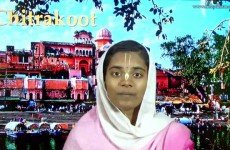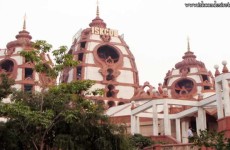Paryaya System
The Swamijis of the eight Mathas conduct the worship at Shri Krishna Matha by turns, for two years each. This tenure of worship by rotation is known as ?Paryaya?. The Swamiji in charge of worship at any point of time is called ?paryaya Swamiji? and his Matha called the ?Paryaya Matha?.The biennial transfer of the privilege of worship from one Matha to another is celebrated as a grand festival called ?Paryaya Festival?. The handover of charge begins with a grand procession where all the swamijis are brought in decorated palanquins (Pallaki). The outgoing Swamiji receives the Swamijis and then handsover to the incoming Swamiji, the keys to the Shri Krishna Matha and the Akshaya patra (a vessel given by Shri Madhwacharya to the temple for the sake of never-ending Annadana.)
Preparations for Paryaya
The preliminaries start a year before the paryaya ceremony. The foremost among those rituals are
1. Baale unhurt
2. kaki unhurt
3. Katie mahout
4.batter mahout
1. Baaale unhurt
All this is done on an auspicious day about a year before the Paryaya festival. Plantain and Tulsi groves are formally set up on that day.
Each paryaya swamiji requires Tulsi leaves for daily service at the Krishna Matha and plantain leaves for feasts. Banana is needed for offerings to the deity. Hence the swamiji has to start cultivating these plants in the gardens belonging to his Matha so that by the time the paryaya period starts the rituals can commence.
On the day of mahout, priests pray to the nine planets first. Then Matha workers carry the Tulsi seedlings and the plantain which is to be planted. The procession moves towards the Krishna Matha. The royal elephant and other paraphernalia of the Matha participate in this ritual. They offer prayers at the temples of Chandreswara and Anantheswara. They also pray before Krishna?s shrine and offer coins. The prayer goes like this, ?Please bless us so that there is no dearth of Tulsi for your worship and plantain leaves for dinner.? They also bow to the deities of Sri Mukhyaprana and Sri Madhvacharya and go back to their Matha. Then they plant Tulsi saplings and banana plants.
2. Kaki mahout
Within two months of celebrating the Bale mahout, they celebrate Kaki mahout. Thousands of people are fed during the period of paryaya. During special festivals, about 5,000 to 10,000 people are fed, so it is important to have considerable stock of rice. The procession starts from the Matha. A pack of rice is decorated and kept in a palanquin. It is covered with a silken cloth. Devotees go behind the palanquin with packs of rice on their head. All officers of the Matha participate in the procession. They pray at the temples of Chandreswara and Anantheswara.
The swamiji conducts this ritual himself. Other swamijis are also invited to the Matha and honoured.
3. Katie mahout
This is celebrated about six months before the commencement of the paryaya. After collecting rice, arrangements are made to gather firewood for cooking, which is why this ceremony is held.
Storing firewood in an artistic manner is the specialty of Udupi. Firewood is piled up in the shape of a beautiful chariot. It is visible in the North-East corner of the Madhva Sarovara.
Artists observe this ritual to start building this beautiful chariot out of rugged pieces of wood. After propitiating the nine planets, the procession starts with workers carrying loads of firewood. They salute deities in different temples and reach the place behind the cattle-shed where the chariot of firewood is to be constructed. After ritual of purifying the ground, artists begin their work.
Many skilled artists pile up firewood and arrange it in the shape of a chariot, 55 feet high. A few days before the Katie mahout of the next paryaya this chariot is dismantled and the firewood is used for cooking.
4. Batter muhurta
This ritual takes place about seven or eight weeks before the paryaya. It is meant to gather paddy from the new crop before the paryaya ceremony. All these rituals are observed to gather leaves to serve food. They collect rice and firewood for cooking. The sole aim is continuation of the tradition of mass feeding. That is why Lord Krishna of Udupi is known as ?Anna Brahma.?
After the prayer, the procession starts from the Matha. A bag of paddy is placed in a palanquin and covered with silken cloth. After saluting the deities in different temples, the procession enters the Badagu Maalige……..
To know more, visit – www.holydham.com/udupi-dham/

















































































